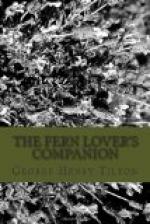Pteris aquilina. PTERIDIUM LATIUSCULUM[1]
[Footnote 1: The use of small capitals in the scientific names indicates in part the newer nomenclature which many botanists are inclined to adopt.]
Fronds broadly triangular, ternate, one to three feet high or more, the widely spreading branches twice pinnate, the lower pinnules more or less pinnatifid. Sporangia borne in a continuous line along the lower margin of the ultimate divisions whose reflexed edges form the indusium. (Greek, pteron, a wing, the feathery fronds suggesting the wings of a bird.)
[Illustration: Common Bracken or Brake, a Sterile Frond. Pteris aquilina (Providence County, R.I.)]
[Illustration: A Fertile Frond of Common Bracken. Pteris aquilina (Suffolk County, Mass.)]
“The heath this night must be my
bed,
The bracken curtain for my head.”
SCOTT.
The outlines of the young bracken resemble the little oak fern. It flourishes in thickets and open pastures, often with poor soil and scant shade. It is found in all parts of the world, and is said to be the most common of all our North American ferns. In a cross section of the mature stipe superstition sees “the devil’s hoof” and “King Charles in the oak,” and any one may see or think he sees the outlines of an oak tree. It was the bracken, or eagle fern, as some call it, which was supposed to bear the mysterious “fern seed,” but only on midsummer eve (St. John’s eve).
“But on St. John’s mysterious
night,
Confest the mystic fern seed fell.”
This enabled its possessor to walk invisible.
“We have the receipt for fern-seed,
We walk invisible.”
SHAKESPEARE.
The word brake or bracken is one of the many plant names from which some of our English surnames are derived, as Brack, Breck, Brackenridge, etc., and fern (meaning the bracken) is seen in Fern, Fearns, Fernham, Fernel, Fernside, Farnsworth, etc. Also, in names of places as Ferney, Ferndale, Fernwood, and others. Although the bracken is coarse and common, it makes a desirable background for rockeries, or other fern masses. The young ferns should be transplanted in early spring with as much of the long, running rootstock as possible.
Var. pseudocaudata has longer, narrower and more distant pinnules, and is a common southern form.
[Illustration: Var. pseudocaudata]
2. MAIDENHAIR. Adiantum
Ferns with much divided leaves and short, marginal sori borne at the ends of free-forking veins, on the under side of the reflexed and altered portion of the pinnules, which serves as an indusium. Stipes and branches of the leaves very slender and polished.
(Greek, unwetted, because drops of water roll off without wetting the leaves.)
(1) COMMON MAIDENHAIR. Adiantum pedatum
A graceful fern of shady glen and rocky woodland, nine to eighteen inches high, the black, shining stalks forked at the top into two equal, recurved branches, the pinnae all springing from the upper side. Pinnules triangular-oblong, bearing short sori on their inwardly reflexed margins which form the indusium.




